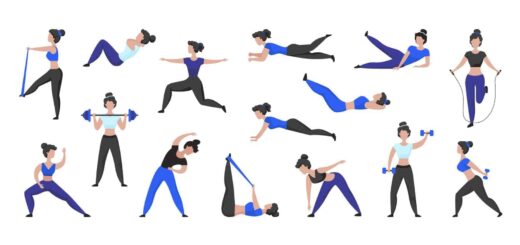Should I Go to the Gym Today?
You wake up feeling groggy and contemplate whether or not you should go to the gym today. The struggle is real – your warm bed has never been more inviting, the weather outside is dreadfully cold, and the thought of exercising seems daunting. Before you make your decision, let’s explore the reasons why going to the gym might be a great idea for you today.

Benefits of Going to the Gym
Improved physical health
Going to the gym regularly offers numerous benefits for your physical health. Engaging in exercises like cardio workouts, weight training, and flexibility exercises helps to strengthen your muscles, improve your endurance, and enhance your overall physical fitness. It can also contribute to better cardiovascular health, lower blood pressure, and improved lung function.
Weight management
Maintaining a healthy weight is crucial for your overall well-being. Going to the gym can support your weight management goals by increasing your calorie burn through physical activity and building lean muscle mass. Regular exercise at the gym, combined with a balanced diet, can help you achieve and maintain a healthy weight over time.
Increased energy levels
If you often find yourself feeling tired or lethargic, going to the gym can help combat that. Physical activity has been shown to boost energy levels by releasing endorphins, the body’s natural feel-good hormones. Regular gym sessions can provide you with the energy you need to tackle daily tasks and activities with enthusiasm and vigor.
Reduced stress and improved mental health
Exercise is not only beneficial for your physical health but has also been proven to have positive effects on your mental well-being. Going to the gym and engaging in physical activity triggers the release of endorphins, which are known to elevate mood and reduce stress. Regular exercise can also boost self-confidence, improve cognitive function, and help alleviate symptoms of anxiety and depression.
Improved sleep quality
If you struggle with getting a good night’s sleep, going to the gym can help improve your sleep quality. Physical activity helps regulate your sleep patterns and promotes better sleep. Additionally, exercising during the day can help tire your body, making it easier to relax and fall asleep at night.
Boosted immune system
Regular exercise can strengthen your immune system and reduce your risk of certain illnesses and infections. Going to the gym helps to increase blood flow and circulation, allowing immune cells to move more efficiently throughout your body. Exercise also promotes the production of antioxidants and antibodies, which help protect against disease and enhance overall immune function.
Considerations for Going to the Gym
Current health condition
Before starting any exercise routine, it’s crucial to assess your current health condition. If you have any underlying health conditions or injuries, it’s advisable to consult with a healthcare professional before beginning a gym regimen. They can provide guidance and recommend appropriate exercises to ensure your safety and prevent any exacerbation of your condition.
Fitness goals
Setting clear fitness goals is vital when deciding to go to the gym. Whether you aim to build muscle, improve flexibility, lose weight, or increase cardiovascular endurance, having specific goals in mind will help you tailor your workouts and track your progress effectively.
Time availability
Finding time in your schedule for gym sessions is essential for consistency and maximizing the benefits. Assess your daily routine and identify pockets of time that can be dedicated to exercise. Whether it’s before or after work, during lunch breaks, or even on weekends, prioritize exercise and make it a non-negotiable part of your schedule.
Financial considerations
Gym memberships often come with a cost, so it’s important to consider your budget when deciding to join a gym. Research different gyms in your area, compare membership prices, and see which one fits within your financial means. Additionally, consider whether the cost of a gym membership is worth it for the benefits and convenience it provides compared to other alternatives.
Safety precautions
To ensure your safety while exercising at the gym, it’s important to follow proper safety precautions. This includes learning how to use gym equipment correctly, maintaining proper form during exercises to prevent injuries, and knowing your limits. Familiarize yourself with the gym’s safety protocols and guidelines to create a safe workout environment for yourself and others.
Gym accessibility
Consider the proximity and accessibility of the gym when making your decision. Choose a gym that is conveniently located, whether it’s near your workplace or home, to minimize travel time and make it easier for you to incorporate gym sessions into your routine. Additionally, check the gym’s operating hours to ensure they align with your schedule.
Alternatives to the Gym
Home workouts
If going to the gym is not feasible or convenient for you, working out at home can be a great alternative. There are various home workout programs available online, ranging from bodyweight exercises to workout videos that require minimal equipment. Designating a dedicated space in your home for exercise and investing in basic workout equipment like dumbbells or resistance bands can help you establish an effective home workout routine.
Outdoor activities
Take advantage of the outdoors and engage in physical activities such as walking, jogging, hiking, or biking. Outdoor activities not only provide an opportunity for exercise but also allow you to connect with nature and enjoy fresh air. Whether it’s exploring local trails, participating in outdoor sports, or simply going for a stroll in the park, outdoor activities can be a refreshing and enjoyable alternative to the gym.
Group fitness classes
Group fitness classes offer a sense of community and motivation while providing a structured workout regimen. Many gyms and fitness centers offer a wide range of classes such as yoga, Zumba, spinning, HIIT, and more. Joining a group fitness class allows you to work out under the guidance of a qualified instructor and interact with like-minded individuals who share similar fitness goals.
Online fitness programs
The rise of technology has made it easier than ever to access fitness programs online. There are countless websites, apps, and social media platforms that offer a variety of workout programs and resources. Whether you prefer following pre-recorded workouts or participating in live virtual classes, online fitness programs provide flexibility and convenience, allowing you to exercise from the comfort of your own home.
Dance classes
For those who enjoy the combination of exercise and creativity, dance classes can be a fun alternative to traditional gym workouts. Whether it’s salsa, hip hop, ballet, or any other dance style that piques your interest, taking dance classes offers a full-body workout while honing your dance skills. It’s a great way to improve coordination, flexibility, and cardiovascular endurance while having a blast.
Sports activities
Engaging in sports activities provides an opportunity for physical exercise while enjoying the competitive and social aspects of team or individual sports. Whether it’s basketball, tennis, soccer, swimming, or any other sport that appeals to you, participating in sports activities can help you stay active, improve your fitness levels, and meet new people with similar interests.
Motivation and Accountability
Setting goals
Setting realistic and achievable goals is key to staying motivated and accountable. Whether it’s short-term goals such as attending the gym a certain number of times per week or long-term goals like running a marathon, having something to strive for and track your progress keeps you motivated on your fitness journey.
Finding a workout buddy or partner
Having a workout buddy or partner can provide accountability and make exercising more enjoyable. Find someone with similar fitness goals and interests and commit to working out together. Having someone to share the experience with not only provides motivation but also makes the gym sessions more enjoyable and creates an opportunity for friendly competition.
Joining a fitness community
Joining a fitness community, whether online or in-person, can provide a sense of belonging and support. Engage with others who have similar fitness goals by joining fitness forums, Facebook groups, or attending fitness-related events in your community. Sharing your progress, asking for advice, and providing support to others can help fuel your motivation and create a sense of accountability.
Tracking progress
Tracking your progress is essential to stay motivated and see the results of your hard work. Keep a workout journal or use fitness tracking apps to record your workouts, track your improvements, and set new goals. Seeing tangible evidence of progress can boost your motivation and encourage you to keep pushing forward.
Rewarding yourself
Celebrate your achievements along the way by rewarding yourself for reaching milestones or sticking to your workout routine. Treat yourself to something you enjoy, such as a massage, a new workout outfit, or a relaxing day off. Recognizing and rewarding your efforts not only boosts morale but also reinforces positive behavior and helps maintain motivation.

Overcoming Excuses
Making time
One of the most common excuses for not going to the gym is lack of time. However, by prioritizing exercise and incorporating it into your daily routine, you can make time for the gym. Set a specific time each day for your workout and treat it as an important appointment that cannot be missed. Remember, even short workout sessions can be effective, so don’t feel discouraged if you can’t dedicate hours to the gym.
Lack of motivation
Motivation can fluctuate, but it’s important to find strategies to stay motivated even on days when you don’t feel like going to the gym. Remind yourself of your goals, visualize the benefits of exercise, and find sources of inspiration that resonate with you. Additionally, mix up your workout routine, try new exercises or classes, or listen to music or podcasts that energize and motivate you.
Tiredness or fatigue
Feeling tired or fatigued is a common hurdle when it comes to going to the gym. However, exercise has been shown to boost energy levels and improve fatigue in the long run. Try starting with a lighter workout or engage in activities that are less intense but still promote movement, such as yoga or stretching. You may find that once you get started, your energy levels will increase, and you’ll feel more energized overall.
Feeling self-conscious
Feeling self-conscious at the gym is a common concern, especially for beginners. Remember that everyone is at the gym for their own reasons, and everyone has their own fitness journey. Focus on your own goals and progress rather than comparing yourself to others. Additionally, consider going to the gym during less crowded hours or participating in group fitness classes where the emphasis is on the collective effort rather than individual performance.
Fear of judgment
The fear of being judged by others can be a significant barrier to going to the gym. However, it’s essential to remember that most people at the gym are focused on their own workouts and goals. Those who are experienced in fitness are generally supportive and understanding, as they were once beginners themselves. Instead of worrying about what others may think, shift your focus inward and concentrate on improving yourself.
Weather conditions
Inclement weather can sometimes discourage people from going to the gym, especially if it involves travel. During adverse weather conditions, consider alternative workout options such as home workouts, online programs, or indoor activities like dancing or yoga. These alternatives allow you to continue exercising without worrying about weather conditions or travel logistics.
Creating a Workout Routine
Determining frequency and duration
It’s important to find a workout frequency and duration that suits your schedule and fitness level. Aim for at least 150 minutes of moderate-intensity aerobic activity or 75 minutes of vigorous-intensity activity per week, along with strength training exercises at least twice a week. Start gradually and steadily increase your workout duration and intensity over time, allowing your body to adjust and progress.
Choosing suitable exercises
Select exercises that align with your fitness goals and cater to your preferences. Incorporate a mix of cardiovascular exercises, such as running, cycling, or swimming, along with strength training exercises like weightlifting or resistance training. Additionally, include flexibility exercises such as yoga or stretching to improve mobility and prevent injuries.
Balancing cardio and strength training
Both cardio and strength training are essential components of a well-rounded workout routine. Cardio exercises elevate your heart rate, burn calories, and improve cardiovascular health, while strength training builds lean muscle mass, increases metabolism, and enhances overall strength. Strike a balance between the two to maximize the benefits and achieve a balanced physique.
Incorporating rest days
Rest days are crucial for allowing your body to recover and repair. Overtraining can lead to fatigue, increased risk of injuries, and decreased performance. Integrate rest days into your workout routine, during which you can engage in active recovery activities like stretching, walking, or low-intensity yoga. Use this time to rejuvenate your body and mind, ensuring that you’re ready to return to the gym stronger.
Progression and variety
To continue making progress and prevent plateauing, it’s important to incorporate progression and variety into your workout routine. Gradually increase the intensity, duration, or complexity of your exercises over time to challenge your body and stimulate further improvements. Additionally, try different exercises, classes, or workout styles to keep your routine fresh and exciting, preventing boredom and promoting adherence.
How to Stay Safe at the Gym
Following proper hygiene practices
Maintaining proper hygiene while at the gym is crucial for your safety and the safety of others. Always wipe down equipment before and after use to prevent the spread of germs and bacteria. Wash your hands frequently, especially before and after your workout. Use hand sanitizer if soap and water are not readily available. Additionally, bring a clean towel and a water bottle to stay hydrated throughout your workout.
Using equipment correctly
Proper form and technique when using gym equipment are essential for preventing injuries. Before using any equipment, familiarize yourself with their proper use and functionality. If you’re unsure, don’t hesitate to ask a gym staff member or a personal trainer for guidance. Always start with lighter weights and gradually increase as you become more comfortable and confident in your technique.
Warming up and cooling down
Warming up before your workout and cooling down afterward are essential for preventing injuries and aiding in recovery. Prior to starting your workout, engage in dynamic stretches or light cardio exercises to increase blood flow and elevate your body temperature. After your workout, perform static stretches to cool down and promote muscle recovery. Incorporating these warm-up and cool-down routines into your gym sessions can help optimize your performance and reduce the risk of injury.
Listening to your body
Pay attention to your body’s signals and adjust your workout accordingly. If you experience pain, dizziness, or shortness of breath, it’s important to stop exercising and seek medical attention if necessary. Push yourself within your limits, but also know when to take breaks or modify exercises if something doesn’t feel right. The key is to find a balance between challenging yourself and ensuring your body’s well-being.
Avoiding overexertion
While pushing your limits is part of a workout, it’s crucial to avoid overexertion. Overexerting yourself can lead to injuries, burnout, and long-term negative effects on your health. Gradually increase the intensity and duration of your workouts, and listen to your body’s cues. Remember, progress takes time, and consistency is more important than pushing yourself to the point of exhaustion.
Seeking professional guidance
If you’re new to the gym or unsure about proper exercise techniques, consider working with a certified personal trainer. A trainer can create a customized workout plan, guide you through exercises, and ensure proper form and technique. They can also provide advice on training frequency, intensity, and progression, ensuring that you safely and effectively meet your fitness goals.
Factors Influencing Gym Attendance
Mood and motivation
Your mood and motivation play a significant role in determining whether you go to the gym or not. On days when you feel motivated and upbeat, you’re more likely to prioritize exercise. However, understanding that motivation can fluctuate, finding strategies to boost your mood and maintain motivation can help ensure consistent gym attendance. This can include listening to energizing music, practicing positive self-talk, or visualizing the benefits of exercise.
Availability of gym amenities
Different gyms offer varying amenities and facilities that may influence your decision to go. Consider what amenities are important to you, such as swimming pools, sauna, group fitness classes, or personal training services. Choose a gym that aligns with your preferences and provides the facilities and services that enhance your gym experience.
Preferences for solitude or socialization
Some individuals prefer solitude during their workouts, while others thrive in social environments. Assess your preferences and select a gym environment that matches your needs. If you enjoy socializing and being surrounded by others, a gym with a vibrant community and group classes may be ideal. On the other hand, if you prefer a more individualistic approach, a gym with ample space and fewer distractions may be a better fit.
Convenience and proximity
The convenience and proximity of the gym can greatly impact your decision to attend regularly. Choose a gym that is conveniently located, whether it’s close to your workplace, home, or en route to another frequent destination. When the gym is within easy reach, it eliminates travel time and makes it more likely that you’ll incorporate gym sessions into your daily routine.
Seasonal factors
Seasonal changes can influence gym attendance due to weather conditions or seasonal activities. In colder months, individuals may be more inclined to go to the gym for indoor exercise rather than engaging in outdoor activities. Conversely, during warmer months, outdoor activities may be more appealing. Take seasonal factors into consideration when planning your exercise routine and adjust accordingly to ensure consistency.
Making the Most of Gym Sessions
Setting a workout plan
Before hitting the gym, it’s beneficial to have a workout plan in place. Determine what exercises you’ll be doing, the sets and reps, and the order in which you’ll perform them. Creating a workout plan ensures that you have a structured and efficient workout session, maximizing your time at the gym.
Proper warm-up and stretching
Before diving into your workout, it’s important to warm up your muscles and prepare them for exercise. Engage in dynamic stretches and perform a few minutes of light cardio to increase blood flow to your muscles and increase your heart rate. Proper warm-up reduces the risk of injuries and enhances your overall performance during the workout.
Utilizing different workout equipment
Gyms offer a wide array of workout equipment, ranging from free weights to cardio machines and resistance machines. Take advantage of the variety and incorporate different equipment into your workouts. This adds variety to your routine and targets different muscle groups, providing a well-rounded workout.
Trying new exercises or classes
To keep your gym sessions exciting and prevent boredom, try incorporating new exercises or attending different group fitness classes. Experiment with different workout styles, such as HIIT, Pilates, kickboxing, or circuit training. Not only does this challenge your body and prevent plateauing, but it also introduces new movements and techniques that enhance your overall fitness.
Monitoring heart rate and intensity
Monitoring your heart rate and exercise intensity can help you gauge the effectiveness of your workout and ensure that you’re pushing yourself appropriately. Use heart rate monitors or fitness trackers to track your heart rate in real-time and determine the intensity level at which you’re working. This helps you stay within your target heart rate zone for optimal cardiovascular conditioning and calorie burn.
Incorporating interval training
Interval training involves alternating between periods of high-intensity exercise and recovery periods. This form of training is effective in improving cardiovascular fitness and burning calories. Incorporate intervals into your cardio workouts, such as alternating between sprinting and walking on the treadmill or cycling at a high intensity and a low intensity. Interval training can make your gym sessions more challenging and efficient.
Conclusion
When deciding whether or not to go to the gym, several factors should be taken into consideration. Assessing the benefits of going to the gym, considering alternatives, and addressing common excuses can help you make an informed decision that aligns with your personal goals and priorities. Whether you choose to go to the gym or explore other fitness options, it’s crucial to listen to your body, cultivate motivation and accountability, and prioritize enjoyment and sustainability in your fitness journey. By finding the right balance, you can embark on a fulfilling fitness routine that enhances your physical health, mental well-being, and overall quality of life.

















It's great that you talked about how business insurance can provide financial protection against unexpected events and help ensure the…
I like that you mentioned how business insurance is essential for protecting your bottom line and the long-term viability of…